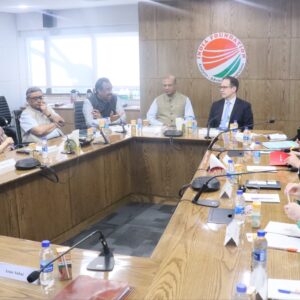Is the world moving towards multipolarity, or at least towards a new world order? In the last century, close to the end of the Second World War, Henry Morgenthau Jr., at the opening of the Bretton Woods conference, observed: “The transcendent fact of contemporary life is this: … the world is a community.” This thought had been enunciated thousands of years earlier in India, where the Maha Upanishad mentions the ancient Indian philosophical concept of “Vasudhaiva Kutumbakam” (The world is a family). But were the institutions created after World War II to govern the world order focused on creating an equitable world or to perpetuate the stranglehold over power in the hands of a few?
When India gained independence, the philosophy behind the phrase “Vasudhaiva Kutumbakam” found utterance in the voices of its leaders, but India was not a power that could influence global decisions. During India’s G20 presidency, the summit held in New Delhi in September 2023 was themed on Vasudhaiva Kutumbakam—One Earth, One Family, One Future. Prime Minister Modi has used this phrase while advocating for peace in the Russia-Ukraine War and the Israel-Hamas conflict and during his frequent interactions with world leaders for a more equitable world order.
Eight decades after the formation of global institutions such as the United Nations (UN), the International Monetary Fund (IMF) and the World Bank, the questions regarding their relevance in today’s world are becoming louder and more constant. When these institutions were established, the world order radically differed from the one we live in today. There was little concern then about issues such as climate change. Terrorism was confined to limited geographical pockets, and its spread was not difficult to contain. The world had yet to make those rapid technological advancements that define the present battle space, especially in communications and long-range precision weapon systems. The space race was in its infancy, and cyber warfare was not a threat. But all that has changed now. The world is literally “on fire,”[i] as the rather provocative article by the Stockholm Environment Institute states. This raises the question: Can the existing institutions of global governance adapt to change? Or are new instruments required to replace the ones formed about eight decades ago?
Recognising the need for change, UN Secretary-General António Guterres issued a policy brief in July 2023 titled “A New Agenda for Peace.” It outlines his vision for peace and security in a world in transition, aiming to address current conflicts, foster sustainable peace, and promote international cooperation. “What is at stake,” Guterres wrote, “is not the future of the United Nations, but of our nations and humanity. The possibility of global devastation, whether from nuclear weapons, climate change, diseases or war, or even technology run amok, is tangible and increasing. Member States will need to find new ways of working together despite the increasing mistrust that has permeated international relations.”[ii]
The BRICS (Brazil, Russia, India, China, and South Africa) Summit, held in Kazan, Russia, from 22-24 October 2024, is a pointer to how a future world order could emerge. A plurilateral organisation, BRICS was founded pursuant to a meeting of the four leaders of BRIC (Brazil, Russia, India, and China) in St Petersburg, Russia, on the margins of the G8 Outreach Summit in July 2006. Two months later, in September 2006, the group was formalised as BRIC during the first BRIC Foreign Ministers Meeting held on the sidelines of the General Debate of the UN Assembly in New York City. After that, the first BRIC summit was held in Yekaterinburg, Russia, on 16 June 2009.[iii] The Kazan Summit has added more members to BRICS— Egypt, Ethiopia, Iran, Saudi Arabia, and the United Arab Emirates (UAE), to form the BRICS+. Many countries have applied for membership, so the organisation is set to grow.
BRICS+ challenges the structural advantages that advanced market economies continue to enjoy,[iv] but it is not an anti-West grouping. It allows operating within and outside groupings like the G20 for India and other middle powers. This fact precludes the world from being divided into rigid blocs, a throwback to the Cold War years. The West, for now, is adopting a wait-and-watch attitude. Still, there is no reason for alarm or confrontation, especially if the West addresses emerging powers’ concerns, legitimate hopes and aspirations.
China’s Belt and Road Initiative (BRI) also seeks to reshape the geopolitical landscape by funnelling development finance to extend its economic and political influence. Decarbonisation will rewrite the geopolitical script by changing the value of specific resources—diminishing the relevance of fossil fuels while increasing the importance of rare earths.
An American political scientist, G. John Ikenberry, has viewed the emerging change as dividing the world into three major groupings—The West led by the US; the East comprising Russia and China; and the developing world. According to Ikenberry, these ‘three worlds’, as he put it, are not blocs but loose evolving factions with situation-specific dynamics. He characterises plurilateral organisations such as the Quad, BRICS, the SCO and other regional organisations in this manner. An interesting facet of the view is that Ikenberry posits that Asia is at the forefront of the change that will come about and that India will be a critical driver of that change.[v]
India’s External Affairs Minister, Dr S. Jaishankar, alluded to these geopolitical shifts while addressing the Asia Society Policy Institute in New York on September 25, 2024. While emphasising the need to rebalance the global order, he noted that economic, political, and demographic transformations over the last eight decades have propelled several Asian countries into the top twenty world economies. Among these, India—ranked as the tenth-largest economy just a decade ago—has now risen to fifth place and is projected to become the third-largest by the decade’s end. He spoke of the inevitability of change and argued for a multipolar world with more independent decision-making centres as international politics was redirecting toward finding convergences and overlapping interests among nations.[vi] The United States will contest this change and resist efforts to alter the status quo. China will continue its quest for global leadership, making a future conflict all the more plausible. The Global South, though not a pole in the conventional sense, will significantly influence the changes that occur in the world order. India’s role, too, will be critical.
India’s Neighbourhood
The volatility in India’s neighbourhood reflects the transformation underway in the global order. Power struggles, shifting alliances, increased cooperation in some areas, and intensified competition in others are all becoming more frequent. Asia remains the focal point of these developments, driven by India’s rise, Japan’s developed economy, China’s bid to challenge U.S. dominance, West Asia’s energy reserves and the growth of ASEAN. How the India-China contestation plays out will be critical to any future outcome of the new world order.
The recent rapprochement between India and China in Eastern Ladakh does not signify a significant forward movement in the relationship between the two countries. Still, it indicates that the two countries can find mechanisms to ratchet down tensions and work around each other’s core concerns. China, for now, advocates a multi-polar world but remains fixated on being the sole pole in Asia. The contestation for power will thus remain. China’s President Xi Jinping has clearly articulated his vision for China as a world leader in comprehensive national strength and global influence by 2049.[vii] India, too, aims to be a developed country by 2047. There will thus be cooperation, competition and contestation between the two countries. How this plays out will impact the new world order.
In the quest for dominance while supporting India’s rise, the West would not like to see India grow to the extent that it would be a competitor to their economic and other interests. The overthrow of the democratically elected Sheikh Hasina government in August this year had US backing, as seen by Washington’s support for Nobel laureate Muhammad Yunus, perceived as a U.S. protégé, to head the interim government in Bangladesh. In Bangladesh, the US played for its long-term strategic interests, designed to keep pressure on India and influence Indian foreign policy to align with Western interests. Developments in India’s Northeast and some other parts of India also point to the role of external agencies in keeping India embroiled in internal issues to slow down India’s rise.
China, too, is wary of India’s rise, and the tensions along the India-Tibet border are a concomitant result of Beijing’s focus on a unipolar Asia. It also reflects in China’s support for separatist movements in India’s Northeastern states bordering Myanmar. For many decades now, China has also used Pakistan as a proxy to contain India. The China-Pakistan nexus extends to the strategic domain and manifests in the China-Pakistan Economic Corridor (CPEC), designed to open China to the warm waters of the Indian Ocean via the Gwadar port. China’s foray into the Indian Ocean also poses a challenge for India. The network of strategic ports from the Kyaukphyu Port in Myanmar to Gwadar in Pakistan, while designed to secure China’s energy routes through the Indian Ocean, also serve as tools to encircle India strategically.
In response, India has pursued its Act East Policy, with ASEAN at its core. The Quad—a partnership involving India, the U.S., Japan, and Australia—advances India’s vision of a Free and Open Indo-Pacific and extends its influence to Australia and beyond. While India aligns with the U.S. and other Western nations in the maritime domain, differences remain on continental issues, as seen in India’s neutral stance on the Russia-Ukraine conflict.
Some of India’s smaller neighbours—Nepal, Sri Lanka, and the Maldives—seek to maximise their advantage by balancing ties between India and China. However, India’s cultural and civilisational links with Nepal and Sri Lanka and its geographic proximity to the Maldives provide it with a strategic edge. Through its ‘Neighbourhood First Policy,’ India has prioritised deepening physical, digital, and people-to-people connectivity with neighbouring countries and expanding trade and commerce. Over the past decade, India has taken a generous and non-reciprocal approach to regional engagement, a strategy it will likely maintain despite occasional setbacks.
As India’s global influence grows, it would be unrealistic to expect a frictionless environment. The challenges India faces—geopolitical, economic, or strategic—must be factored into its long-term growth strategy. Connectivity will remain pivotal to India’s ambitions. The proposed India-Middle East-Europe Economic Corridor (IMEC), linking India with Europe and the Atlantic, and the Trilateral Highway through Myanmar, connecting India to the Pacific, illustrate India’s increasing centrality in global trade and geopolitics. This connectivity, stretching from the Atlantic to the Pacific, will have far-reaching strategic and economic implications, underscoring India’s evolving role in shaping the future of the global order.
Author Brief Bio: Maj. Gen. Dhruv C. Katoch is Editor, India Foundation Journal and Director, India Foundation.
References:
[i] https://www.sei.org/perspectives/transitioning-to-a-new-global-order/
[ii] https://dppa.un.org/en/a-new-agenda-for-peace
[iii] https://brics2021.gov.in/about-brics
[iv] https://carnegieendowment.org/research/2024/10/brics-summit-emerging-middle-powers-g7-g20?lang=en
[v] G John Ikenberry, Three Worlds: the West, East and South and the competition to shape global order, available at https://academic.oup.com/ia/article/100/1/121/7506681
[vi] https://www.mea.gov.in/Speeches-Statements.htm?dtl/38341/Remarks_by_EAM_Dr_S_Jaishankar_at_Asia_Society_Policy_Institute_in_New_York
[vii] https://www.strategictranslation.org/articles/predicting-the-future-chinas-composite-national-strength-in-2049




